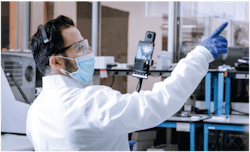Quality and transparency across the entire life cycle of pharmaceutical manufacturing are crucial to safety and access to health care around the world.
With the pressure on the industry to produce affordable medication for growing patient populations in developed and developing nations alike, regulatory authorities must ensure that manufacturers continue to deliver quality products. This requires not only full compliance with ever-increasing standards of quality but also full transparency into manufacturing processes.
Audits have always been an integral part of maintaining safety, quality and compliance across the pharma industry and supply chain. However, the COVID-19 pandemic has created an uncertain regulatory inspection roadmap, as well as restrictions on conducting internal supplier audits.
Given this uncertain environment, increasing the rigor and frequency of audits is an important component for protection against continued supply disruptions. If anything, regulators and inspectors will be taking a more hands-on approach to ensure compliance with good manufacturing practices and quality systems.
This means that companies must prepare to meet rising regulatory expectations across all of their sites and locations, especially those in emerging markets. For the past few years, the U.S. Food and Drug Administration (FDA) has been considering a system to measure and rate a drug manufacturer’s quality management maturity. This greater demand for quality will benefit companies that can execute a robust system of their own.
Fortunately, there is new technology and guidance that is equipping companies with a strategic foundation for their future audit protocol. Having a predefined plan to implement new data capture, analysis and communication tools can also help companies reduce inspectional surprises.
Here are four steps to building a successful hybrid inspection model.
Step 1: Determine which audits can be conducted remotely
Compliance experts advocate for a risk-based approach to determining which supplier audits need boots on the ground versus which can be conducted remotely. This means that a risk assessment should be con- ducted to determine the highest-risk areas of concern for an organization. The decision to conduct remote audits depends on a range of factors and often differs for each company.
Be sure to ask questions such as:
- Is the supplier new?
- Is there a history of non-compliance?
If there is a serious safety concern, experts recommend an in-person visit. However, for many other situations, remote audits are not only suitable, but a more beneficial option.
There are several tools available for companies to use depending on their goals and whether they would like to conduct the audit internally or work with a third-party supplier.
During the pandemic, many companies began substituting in-person audits with standard video conferencing tools out of necessity. However, standard video platforms were made for faces, not places. Using standard video platforms to conduct audits can provide limited data and ultimately lead to inaccurate conclusions about the site. Technology should support as close to an in-person experience as possible.
There are several factors to consider in a platform, such as:
- 360-degree capabilities: Does the platform capture the entire site and allow for a 360-degree view of processes, systems and even hazards? The auditor should be able to explore and interact with a given site or facility without being limited to the camera operator’s point of view.
- Continuous recording: Does the platform ensure that all activities are captured and can be reviewed later?
- Unrestricted camera movement: Can users follow the action without disruption during audits? This is especially useful when transitioning between high-risk and low-risk areas.
- Connection to the factory floor: Does the platform allow inspectors to communicate directly with staff, manage visitors and monitor equipment? Real-time interaction is critical for making auditors feel like they are physically present.
- Connectivity requirements: Is the technology limited a WiFi connection? For large facilities with spotty connections, it’s important to find a platform that can work on WiFi or local LTE/5G networks.
- Real-time capabilities: Does the platform provide access to the live stream so that users can monitor site activity in real time? With these capabilities, companies are now able to comprehensively audit their supplier sites remotely. Pre-recorded sessions will not work.
- Collaboration features: Offerings such as document sharing and annotation can help auditors pull up checklists and documents in real time.
Step 3: Develop a risk- based audit plan
The next step is to develop an audit plan, which should be tailored for each specific site or supplier. This should include a general timeline for when to perform audits. For example, one company may choose to conduct initial site qualifications remotely followed by an in-person audit annually. Others may choose to conduct audits every six months, depending on the supplier’s history of non-compliance.
Step 4: Preparation
There’s no doubt that virtual audits are different. But are they more difficult? Not necessarily. While certain precautions must be taken, it’s not any more challenging than conducting on-site audits. During a recent Parenteral Drug Association (PDA) remote audits and inspections workshop, many companies and consultants cited connectivity issues as the main concern for virtual audits. However, preparation goes a long way when hosting a remote audit.
Tips for success:
- Identify a separate remote protocol: Transcribing a site visit on the fly is not easy. For this reason, companies should have a dedicated remote protocol in place. This includes identifying a separate room and determining who will be present.
- Be clear on SOPs and documentation: It’s important to have documented SOPs and share them with all parties ahead of time. This ensures that all parties are on the same page and paperwork is completed accurately.
- Consider and test connectivity: It’s important to ensure the site has proper bandwidth and connectivity before hosting a virtual audit. The first step is to test and make sure the site’s internet speed is fast enough to support remote activity. If the connection is not strong, companies will want to ensure their collaboration tools can work adequately with local LTE or 5G networks.
- Ensure all relevant personnel are trained on the technology: It is important to establish who will be present at the remote location. If possible, make sure they are trained on the technology ahead of time.
- Create a clear schedule: To ensure compliance and transparency, it’s important to communicate a clear schedule to all parties ahead of time.
- Determine recording and security protocols: Recording is a great feature of 360-degree collaboration but recording restrictions must be determined ahead of time.
Benefits of a hybrid protocol
Having a remote option that provides a feeling of being physically present is a significant business asset. Rather than playing catch-up during COVID, companies can be strategic when creating and executing a hybrid audit protocol.
A hybrid strategy can also help preserve key assets such as cost and time. For example, the cost of an average three- day business trip is between $1,200-$2,500 per person. Since audits alone can take 2-3 days, this cost is likely all the more staggering. Therefore, sending a team of auditors to even just four supplier facilities per year will be well over $100,000. Companies can also recuperate time lost on travel. It’s not uncommon for companies to spend more than nine hours in airports and on airplanes during a single site visit. This is time that could be spent focusing on other areas of the business.
A hybrid model means that audits can now be performed while maintaining continuous quality management. This ensures that a supplier’s issues are addressed as efficiently as possible. In turn, this speeds up the time to market for products and services while providing the ability to measure supplier progress in real time.
Finally, the ability to be on-site more frequently adds another layer of transparency to pharmaceutical quality and process protocols. This allows companies to do their due diligence, secure compliance, and focus on other business components.
Virtual audits are not only possible, they’re also powerful and produce tangible results when done right. With the proper planning and execution, companies can leverage this technology to meet their sustainability goals while maintaining compliance standards.


